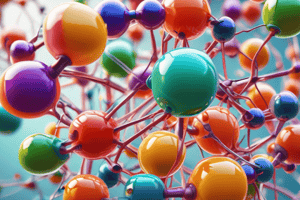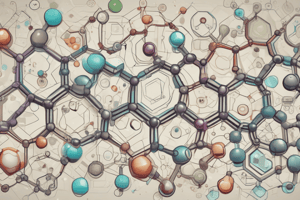Podcast
Questions and Answers
What is a primary factor influencing the reactivity of heterocyclic compounds?
What is a primary factor influencing the reactivity of heterocyclic compounds?
- Ring size and aromaticity
- Molecular weight of the compound
- Steric hindrance of the heteroatom
- Electronegativity of the heteroatom (correct)
Which class of biomolecules is particularly rich in heterocyclic structures?
Which class of biomolecules is particularly rich in heterocyclic structures?
- Nucleotides (correct)
- Amino acids
- Carbohydrates
- Lipids
Which of the following reactions is NOT a common reaction of heterocyclic compounds?
Which of the following reactions is NOT a common reaction of heterocyclic compounds?
- Beta-elimination (correct)
- Nucleophilic substitution
- Ring-opening reactions
- Electrophilic substitution
Which pharmacological application of heterocyclic compounds is NOT mentioned in the content?
Which pharmacological application of heterocyclic compounds is NOT mentioned in the content?
Which of the following heterocycles is NOT a heteroaromatic?
Which of the following heterocycles is NOT a heteroaromatic?
What is a characteristic feature of heteroaromatic compounds?
What is a characteristic feature of heteroaromatic compounds?
What is a common application of heteroaromatics?
What is a common application of heteroaromatics?
Which biological process is NOT a target of heterocyclic compounds in medicine?
Which biological process is NOT a target of heterocyclic compounds in medicine?
Study Notes
Reactivity and Mechanisms
- Heterocyclic compounds exhibit unique reactivity due to the presence of heteroatoms (atoms other than carbon and hydrogen)
- Reactivity is influenced by:
- Electronegativity of the heteroatom
- Ring size and strain
- Aromaticity or antiaromaticity
- Common reactions:
- Electrophilic substitution (e.g., nitration, sulfonation)
- Nucleophilic substitution (e.g., alkylation, arylation)
- Ring-opening and ring-closing reactions
- Oxidation and reduction reactions
Heterocycles in Nature
- Heterocycles are abundant in nature, particularly in:
- Alkaloids (e.g., morphine, cocaine)
- Amino acids (e.g., histidine, tryptophan)
- Nucleotides (e.g., DNA, RNA)
- Vitamins (e.g., thiamine, riboflavin)
- They often exhibit biological activity, such as:
- Enzyme inhibition
- Receptor binding
- Antimicrobial and antitumor properties
Pharmacological Applications
- Heterocyclic compounds are widely used in medicine, including:
- Antidepressants (e.g., fluoxetine, sertraline)
- Anticonvulsants (e.g., carbamazepine, lamotrigine)
- Antibacterial agents (e.g., sulfonamides, metronidazole)
- Antiviral agents (e.g., azidothymidine, lamivudine)
- They are often used to target specific biological processes, such as:
- Neurotransmission
- Cell signaling
- DNA replication
Heteroaromatics
- Heteroaromatics are a class of heterocycles that exhibit aromatic properties
- Examples include:
- Pyridine
- Pyrimidine
- Imidazole
- Thiazole
- Heteroaromatics are characterized by:
- Planarity
- Delocalization of electrons
- High stability
- They are often used in:
- Pharmaceuticals
- Agrochemicals
- Dyes and pigments
Reactivity and Mechanisms
- Heteroatoms influence reactivity in heterocyclic compounds due to their electronegativity
- Ring size and strain impact reactivity, with smaller rings being more reactive
- Aromaticity or antiaromaticity affects reactivity, with aromatic rings being more stable
- Electrophilic substitution reactions occur at electrophilic sites, such as nitration and sulfonation
- Nucleophilic substitution reactions occur at nucleophilic sites, such as alkylation and arylation
- Ring-opening and ring-closing reactions involve the cleavage or formation of rings
- Oxidation and reduction reactions involve the gain or loss of electrons
Heterocycles in Nature
- Alkaloids, such as morphine and cocaine, are a class of heterocyclic compounds found in nature
- Amino acids, such as histidine and tryptophan, contain heterocyclic rings
- Nucleotides, such as DNA and RNA, are composed of heterocyclic bases
- Vitamins, such as thiamine and riboflavin, have heterocyclic structures
- Heterocycles in nature often exhibit biological activity, including enzyme inhibition and receptor binding
- They also exhibit antimicrobial and antitumor properties
Pharmacological Applications
- Heterocyclic compounds are used in medicine to treat various diseases, including depression and epilepsy
- Antidepressants, such as fluoxetine and sertraline, target neurotransmission
- Anticonvulsants, such as carbamazepine and lamotrigine, target neurochemical pathways
- Antibacterial agents, such as sulfonamides and metronidazole, target bacterial cell walls
- Antiviral agents, such as azidothymidine and lamivudine, target viral replication
- Heterocyclic compounds are designed to target specific biological processes, such as cell signaling and DNA replication
Heteroaromatics
- Heteroaromatics are a class of heterocycles that exhibit aromatic properties due to delocalization of electrons
- Examples of heteroaromatics include pyridine, pyrimidine, imidazole, and thiazole
- Heteroaromatics are characterized by planarity, high stability, and electron delocalization
- They are often used in pharmaceuticals, agrochemicals, and dyes and pigments due to their unique properties
Studying That Suits You
Use AI to generate personalized quizzes and flashcards to suit your learning preferences.
Description
Learn about the unique reactivity of heterocyclic compounds and the factors that influence it, including electronegativity, ring size, and aromaticity. Explore common reactions like electrophilic and nucleophilic substitution, ring-opening, and oxidation.




